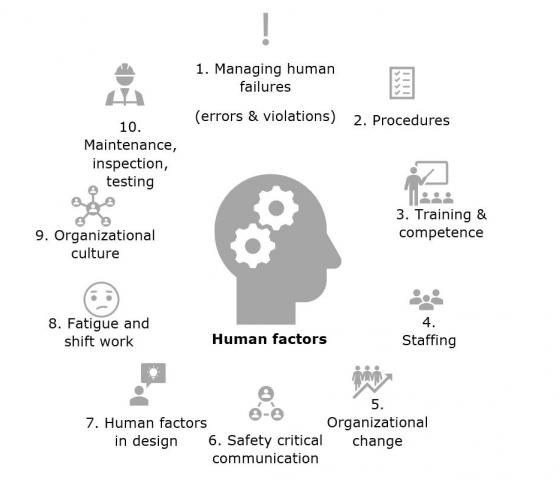
Human factor management is part of health & safety management
Human factors have contributed to various incidents in chemical and process industries. It is essential to understand how people affect the safety of operations in order to effectively manage the overall health and safety of a plant. Various methods can be used to analyse organisational or task related human factors and to prevent or mitigate the incidents caused by human failures.
Many accidents could be prevented through proactive safety management. Efficient safety management decreases accident rates, prevents environmental releases, increases wellbeing at work and prevents asset losses, and enables better business continuity. Sustainability aspects shall also be remembered; companies cannot be sustainable without protecting the safety, health, and welfare of their most important resource: employees.
Human factor management as part of overall health and safety management
In most processes, even with high automation, humans are an integral part of the working system. Thus, it is important to understand how people behave and interact with the system and what kind of consequences can occur with certain actions. Operational processes of chemical and process industries contain large numbers of various hazardous chemicals. It is also typical that processes require a high degree of control to keep process variables and supply of utilities within design and safety limits. Design of tasks has developed during recent years, driven by technology changes, requirements for efficiency, and availability of skilled people. In optimal task design or updates, operators are involved in the early phase of the planning and analysis as operators will interact with various interfaces of the work system.
Efficient safety management, including the consideration of human factors, can save the company money, preserve a good company image, and allows business continuity. Managing human factor aspects within an organization reduces errors and improves communication, reduces work related injuries and sick leaves (lower medical costs), increases employee satisfaction, and ensures balanced workloads. Human factor management aims to ensure that the work procedures and policies of the organisation are compatible with human capabilities, training is sufficient, the workforce is competent, and there is enough spare capacity to deal with emergency situations. The overall productivity and quality of work will likely increase when absenteeism and labor turnover will decrease.

Picture 1: Top 10 human factor aspects in high-hazard industries
Human factor management is a vital part of incident prevention, as human factors contribute to 80% of accidents. There are several catastrophic examples of this, such as the major accidents in Bhopal, Buncefield and at Texas City refinery, which were affected by several human factors including shortage of staff, poor supervision and change of management, fatigue, lack of maintenance, inadequate training and inductions, poor safety culture and leadership. Human failures occurred at different levels of the organisations and directly or indirectly affected the causation of major accidents.
Human factors affect both the 1) design and 2) operations of various processes. The 1) design point of view examines improving human performance by designing effective equipment, tools, workspaces, and tasks. The 2) operational point of view examines how human performance can be improved by enhancing operation-related aspects such as safety culture, procedures, shift systems, and safety critical communications.
Human factors can be analysed with many methods
Human factor management methods include a wide range of approaches with variable attributes. Both qualitative and quantitative methods are used, some more comprehensive and detailed than others. There is also synergies with traditional safety engineering approaches. Advanced human factor management approaches (for example, second and third generation Human Reliability Analyses) examine potential human errors and the conditions which produce errors in a holistic manner.
Typically process safety related deviations are analysed with methods like the hazard and operability study (HAZOP), fault tree (FTA) and safety integrity level assessment (SIL). These methods also take human-related deviations into account on a certain level, but a systematic approach for human factors affecting both process and occupational safety requires the utilization of other type of methods. Some examples of operational human factor management methods types are:
- accident analyses
- human error identification
- human reliability analyses
- workload and staffing analyses
- task analyses and
- safety culture evaluations.
Human error identification methods examine what kind of errors can potentially occur due to human actions. Action Error Analysis is an often-used method of human error identification in the industrial field.
Human reliability analyses examine the human failures and the conditions and factors which contribute to the formation of accidents. One example of such a method is SPAR-H (Standardized Plant Analysis Risk–Human Reliability Analysis Method). SPAR-H considers conditions which are related to the
- human capabilities (fitness for duty, level of experience)
- qualities of the task (complexity, stressors)
- work environment (ergonomics/HMI) and
- operation (the quality of the procedures and work processes)
This quantitative human reliability analysis method gives detailed information of probability of human error in each phase of the investigated task. In general, quantitative human reliability analysis methods can also support investment decisions when the safety level improvements of different technical and organizational changes are compared.
AFRY SAFETY EXPERTS AT YOUR SERVICE
Our global network of HSE experts combined with local experts who has the best possible understanding of local circumstances ensures the optimal solution for every safety assignments. Contact our experts to find out more how we can help you harness the value of safety and ensure the optimal safety of your business including human factor management aspects. Read more about our services: https://afry.com/en/service/health-and-safety-services-process-industries
Authors: Anna Savunen, Heli Pirhonen (2020)
Additional reading related to Human Factors management and sources used:
-
Amati, C. et al., 2016. Human Factors in the Chemical and Process Industries - Making it Work in Practice.
-
Gallimore, J. J., 2014. Importance of Human Factors in Quality Improvement.


